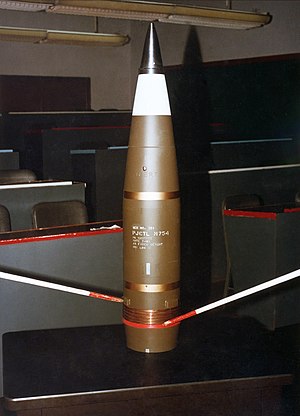| W79 | |
|---|---|
 An inert M754 training version of the warhead | |
| Type | Nuclear artillery |
| Place of origin | United States |
| Service history | |
| In service | 1981 to 1992 |
| Used by | United States Army |
| Production history | |
| Designer | Lawrence Livermore National Laboratory |
| Designed | 1975 to 1981 |
| Specifications | |
| Mass | 200 pounds (91 kg) |
| Length | 44 inches (1,100 mm) |
| Diameter | 8 inches (203 mm) |
| Maximum firing range | 24 kilometres (15 mi) or 30 kilometres (19 mi) with rocket assist[1] |
| Blast yield | 0.1 to 1.1 kilotonnes of TNT (0.42 to 4.60 TJ) (Mod 0), 0.8 kilotonnes of TNT (3.3 TJ) (Mod 1) |
The W79 Artillery-Fired Atomic Projectile (AFAP),[2] also known as XM753 (Atomic RA),[3][4] was an American nuclear artillery shell, capable of being fired from any NATO 8 in (203 mm) howitzer e.g. the M115 and M110 howitzer.[5] The weapon was produced in two models; the enhanced radiation (ERW) W79 Mod 0 and fission-only W79 Mod 1. Both were plutonium-based linear-implosion nuclear weapons.
- The Mod 0 was a variable yield device with three yields, ranging from 100 tons of TNT (420 GJ) up to 1.1 kt (4.6 TJ) and an enhanced-radiation mode which could be turned on or off
- The Mod 1 was fission-only with a fixed 0.8 kt (3.3 TJ) yield, corresponding with the maximum fission only yield of the Mod 0
Both models were 8 in (203 mm) in diameter, 44 in (1,100 mm) long and weighed 200 lb (91 kg). The W79 was developed by Lawrence Livermore National Laboratory, starting in 1975. Production of the different mods took place from July 1981 through August 1986. A total of 550 warheads (325 Mod 0s, 225 Mod 1s) were produced.[6] All units were retired from active service by the end of 1992 with the last shell dismantled at the Pantex Plant in Texas in August 2002.[7]
- ^ Sandia Weapon Review: Nuclear Weapon Characteristics Handbook (PDF) (Report). Sandia National Labs. September 1990. p. 75. SAND90-1238. Archived (PDF) from the original on 2022-01-12.
- ^ "W79 Artillery-Fired Atomic Projectile (AFAP)". Archived from the original on 2021-02-01. Retrieved 2021-01-28.
- ^ Henry E Hudgins (January 1977). Aerodynamics, Dimensions, Inertial Properties and Performance of Artillery Projectiles (PDF) (Report). Picatinny Arsenal. p. 4. Archived (PDF) from the original on 2021-12-19. Retrieved 2021-12-24.
- ^ Thomas B Cochran; William M Arkin; Milton M Hoenig (1984). Nuclear Weapons Databook, Volume I: US Nuclear Forces and Capabilities (PDF) (Report). Natural Resources Defense Council. p. 77. Archived (PDF) from the original on 2021-09-01. Retrieved 2021-12-24.
- ^ LLNL achievements in the 1970s
- ^ Hansen, Chuck (2007). The Swords of Armageddon, version 2. Chukelea Publications. pp. VI-521, VI-522.
- ^ Workers Dismantle Final U.S. Nuclear Artillery Shell